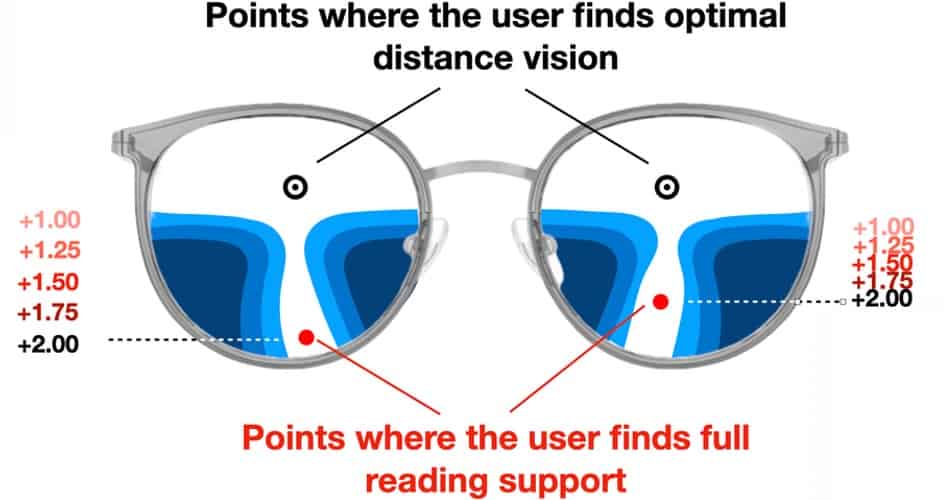The binocular harmonization technology reduces prismatic side effects from each eye which leads to a more balanced experience while reading with progressive lenses. The higher the difference is in lens power in the left and in the right eye the more side effects the wearer will have. The image from the right eye gets deviated in comparison to the left eye.
The binocular harmonization technology takes that information into consideration and changes the progressive corridor lengths for each eye to ensures both eyes have similar reading support when looking down. This technology is available with high-end progressive lenses from Hoya.
Some wearers of progressive lenses really stick to this brand when buying progressive lenses so I wanted to compare the hoya lenses with the Binocular Harmonization Technology with a pair of progressive lenses without the Binocular Harmonization Technology. In this case, I ordered the Eden Zeta lenses from Novacel for comparison.
The Binocular Harmonization Technology can only work when the prescription is different in the left and in the right eye. So I ordered both progressive lenses with a difference of two diopters between the eyes. A bigger difference than that will probably require the wearer to get a slab off to minimize the side effects. Those side effects are:
- Vertigo when wearing progressives
- When you can only read with one eye at a time
- Headaches
For this comparison I had to wear a contact lens to produce the uneven (differing) prescription for the test.
Usually, the person having such a prescription and benefiting from binocular harmonization technology will have a hard time telling what it actually does. In a lot of cases without it, the person having a differing prescription will have a harder time reading. So in this article, I want to actually show you the concept behind this feature and how it worked for me.
What changes with Binocular Harmonization Technology?

The picture above tells you exactly what the binocular harmonization technology does. The difference lays in the power gradient of the progressive lenses. When you see where the height of the red dot (area for full reading support) the right lens here would have to have a shorter progression canal because less looking down is required to get to full reading support.
But isn’t this uneven. No. It is designed to balance out the position you are looking through. Because what shift of the image you can see in the image below is inevitable. When you move your eyes around the images will get deviated. In the image below his effect can be seen. On the right lens, the deviation is more dominant in comparison to the left lens.

With a corridor length that would be the same for both lenses the eyes would have trouble finding the correct reading area because the height is just different due to the deviated pictures for both eyes.
How Well Did the What Is Binocular Harmonization Technology Work for Me?
I was indeed able to see a difference. For this test, I grabbed a polarized vision test for the reading distance. My right eye saw one side and my left eye saw the other side. Comparing both sides the visual acuity was more similar with the Binocular Harmonization Technology compared to the Novacel lenses. But still, I was only able to read for a couple of seconds before my eyes could not focus anymore on the reading test.
For this test, the same frames were used with the same type of adjustments. In the picture below you can see what I saw. The first picture shows the visual experience with Binocular Harmonization Technology (BHT). What you can see I still had had a slight blur on the left compared to the right side of the reading chart.

However it worked better for me without BHT as you can see in the picture below. So while the lenses with BHT gave me a more balanced view on the things I wanted to read the time it took until my eyes gave up was pretty much the same.

This can connect to the fact that I am not used to the different lens powers for each eye. When wearers of spectacles are used to it for years the compensation mechanisms usually work better than in my case. Still, when I had a customer in front of me and he really enjoys reading I would add reading glasses to the progressive lenses. Because with reading glasses the deviation of the pictures can be better controlled.
Approximately 70% of people have anisometropia (differing lens powers) and could therefore benefit from BHT. In most cases do not want the alternatives. They are:
- Slab Off
- Contact lens that evens out the needed prescription
I linked my article about slab offs in the list above. In short, a fine line is added to the progressive lenses to get rid of the differently deviated images. This line however directly crosses the area where the prescription for the mid-distance is found. So you will lose this area.
My recommendation is to wear a contact lens on one eye so the lens power can be balanced in the glasses. This way no deviation takes place and you would have a more relaxed view of the things you want to read. But as most people do not want to add those options to their glasses Binocular Harmonization Technology can be a great feature to enhance your experience with progressive glasses.
I wish you a great day.
